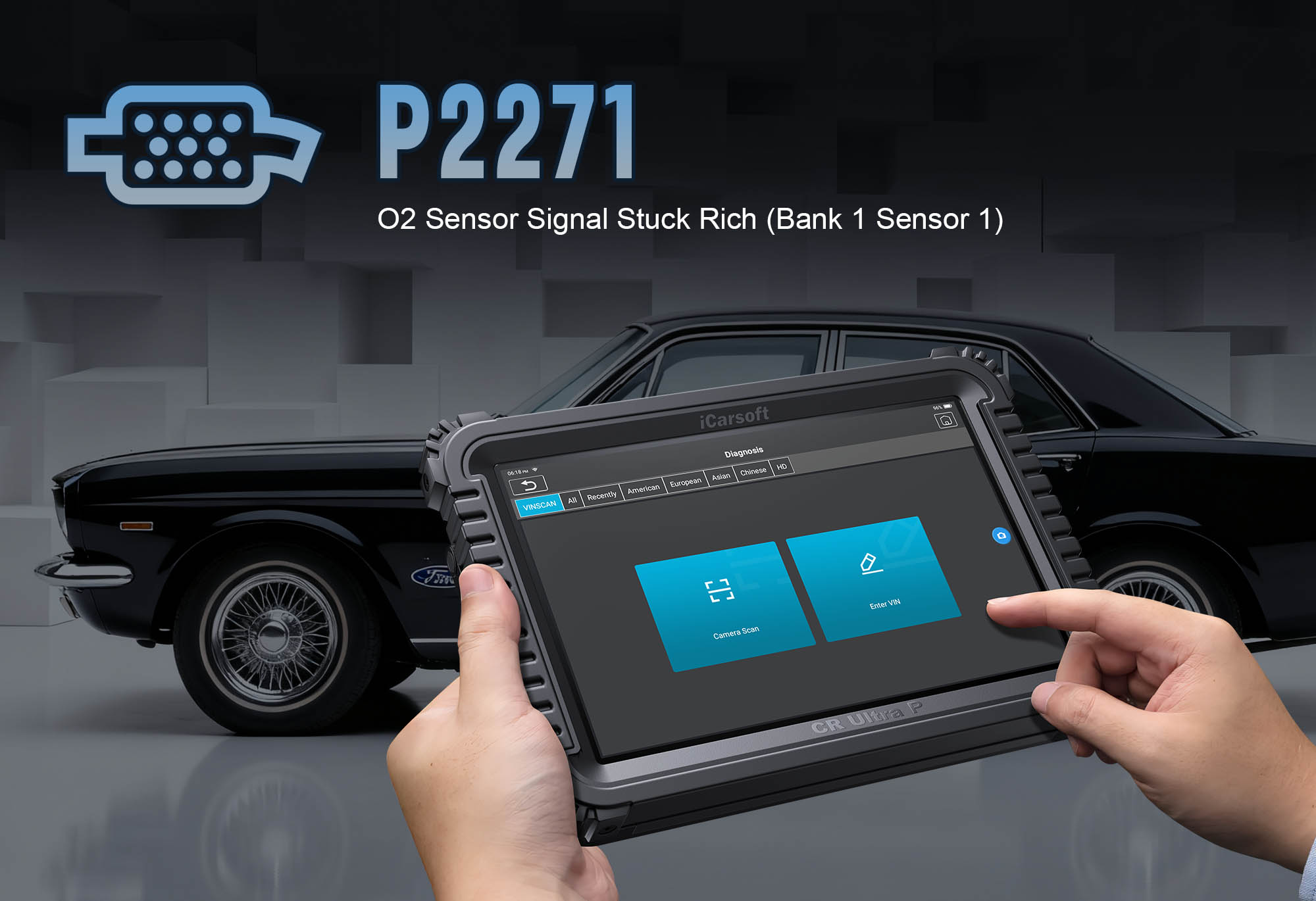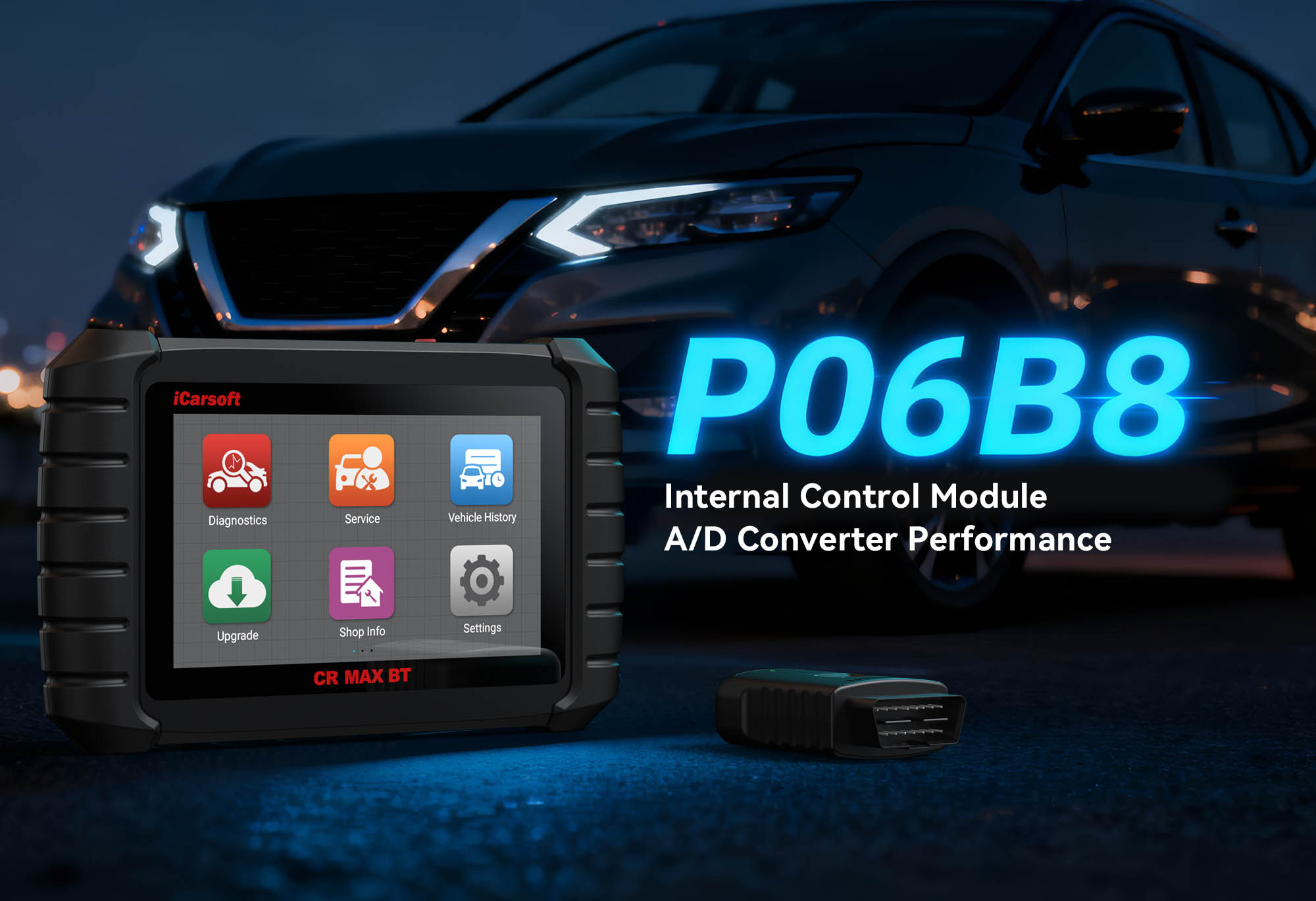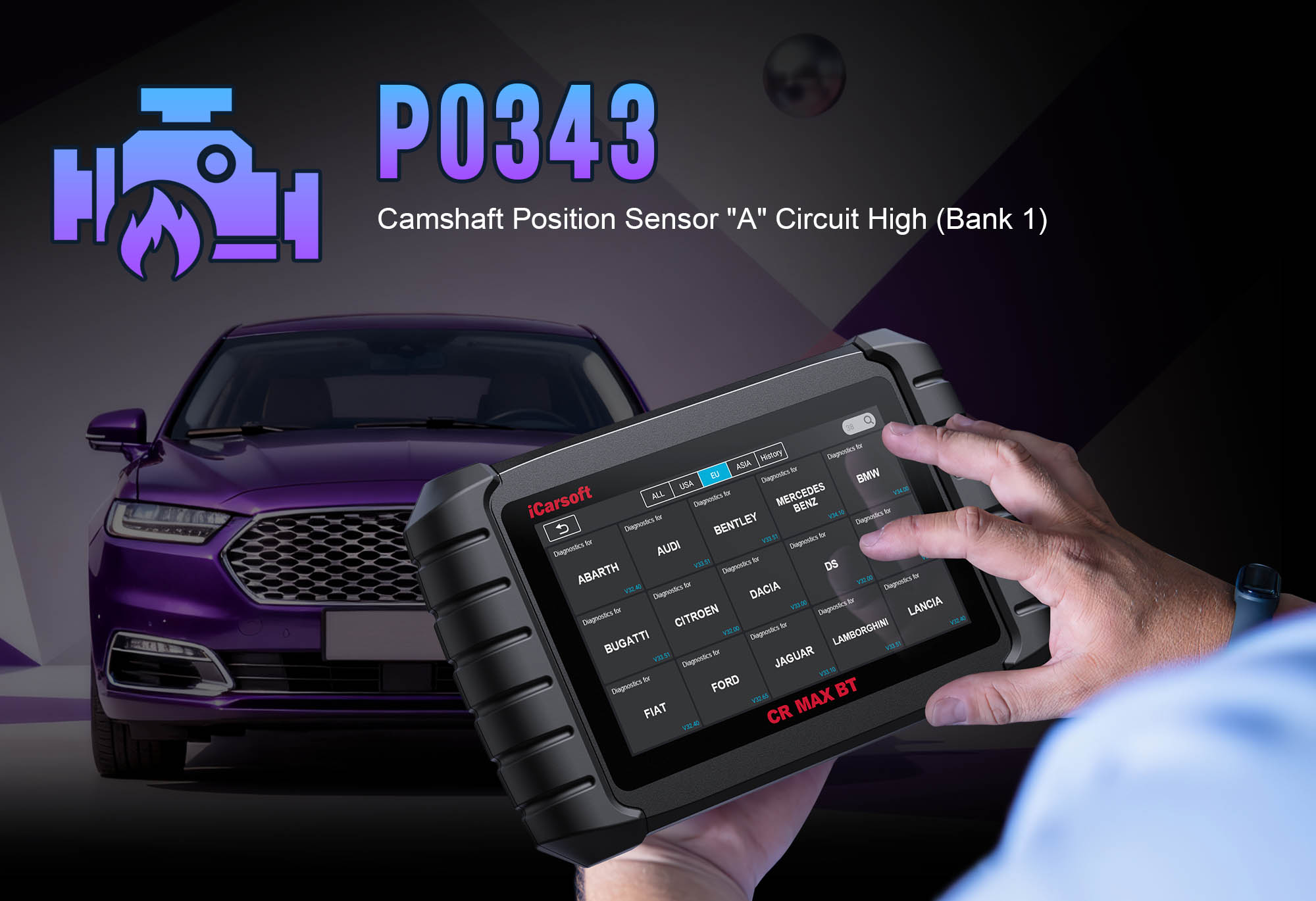Diagnose & Clear P2271 with iCarsoft CR Ultra P
If your vehicle’s check engine light illuminates, you notice rough idle, or fuel consumption spikes, a diagnostic scan will likely return P2271. This OBD-II code stands for "Oxygen (O2) Sensor Signal Stuck Rich (Bank 1, Sensor 2)"—a critical fault indicating the downstream O2 sensor (after the catalytic converter) is sending a continuous "rich" signal to the Engine Control Module (ECM). A rich fuel mixture (too much fuel, too little air) can damage the catalytic converter, reduce fuel efficiency, and trigger emissions test failures.
Basic scanners might only flag an "O2 sensor issue" but can’t analyze live sensor data, test signal integrity, or validate catalytic converter performance—leaving you guessing between a faulty sensor, fuel system leak, or exhaust problem. The iCarsoft CR Ultra P, with its OE-level engine diagnostics, real-time signal tracking, and bi-directional tests, solves this. Below, we break down P2271, its causes, symptoms, and step-by-step resolution—plus 8 FAQs to answer common troubleshooting questions.
What Is P2271?
P2271 targets the downstream O2 sensor (Bank 1, Sensor 2), which monitors exhaust gases after they pass through the catalytic converter. This sensor’s job is to confirm the converter is reducing harmful emissions by detecting changes in oxygen levels. A "stuck rich" signal means the sensor consistently reads high fuel content in the exhaust, even when the ECM adjusts the fuel mixture to lean it out. The ECM triggers P2271 when this signal doesn’t fluctuate within the expected range for a set period.
Symptoms & Common Causes of P2271
Key Symptoms of P2271
-
Illuminated Check Engine Light: The most obvious sign, often paired with related codes like P0138 (O2 sensor high voltage) or P0420 (catalytic converter efficiency low).
-
Poor Fuel Economy: A rich fuel mixture wastes gas, leading to frequent refueling.
-
Rough Idle or Hesitation: Too much fuel can cause the engine to shake at idle or hesitate during acceleration.
-
Strong Fuel Odor: Unburned fuel in the exhaust creates a noticeable gasoline smell.
-
Catalytic Converter Damage: Over time, excess fuel can overheat and destroy the converter, leading to costly repairs.
-
Failed Emissions Tests: High hydrocarbon levels from rich mixtures result in test failures.
Common Causes of P2271
|
Cause
|
Description
|
|
Faulty Downstream O2 Sensor
|
A worn sensor fails to detect oxygen levels accurately, sending a stuck rich signal.
|
|
Fuel System Leaks
|
Leaking fuel injectors, a faulty fuel pressure regulator, or a stuck-open fuel pump relay floods the engine with fuel.
|
|
Exhaust Leaks
|
Leaks before the downstream O2 sensor draw in extra air, misleading the sensor to read rich.
|
|
Catalytic Converter Failure
|
A damaged converter can’t process exhaust gases, causing the sensor to misinterpret readings.
|
|
Wiring/Connector Issues
|
Frayed wires or corroded connectors disrupt the sensor’s signal to the ECM.
|
|
ECM Malfunction
|
Rarely, the ECM fails to adjust the fuel mixture correctly, leading to a persistently rich condition.
|
Why iCarsoft CR Ultra P Excels at Diagnosing P2271
The CR Ultra P outperforms basic tools with features tailored to O2 sensor and exhaust system diagnostics:
Real-Time O2 Sensor Signal Tracking
Monitors upstream (Sensor 1) and downstream (Sensor 2) signals, highlighting stuck or erratic readings.
Bi-Directional O2 Sensor Testing
Activates the sensor manually to verify if it responds to voltage changes—distinguishes sensor faults from wiring issues.
Fuel System Validation
Checks fuel pressure, injector pulse width, and fuel trim values to rule out fuel leaks or regulator problems.
Exhaust System Diagnostics
Uses topology mapping to visualize exhaust wiring and connectors, making leaks or breaks easy to spot.
Global Vehicle Coverage
Supports 200+ brands (Ford, Toyota, BMW, Audi, etc.) and 2018+ models with advanced O2 sensor protocols.
41 Hot Service Functions
Includes catalytic converter efficiency tests, O2 sensor relearn, and ECM reset—critical for post-repair validation.
Component Location Guide
Pinpoints the downstream O2 sensor’s exact position (after catalytic converter) for quick access.
Step-by-Step: Diagnose P2271 with iCarsoft CR Ultra P
-
Confirm P2271 & Gather Data
1. Plug the CR Ultra P into the OBD-II port, power on, and select AutoVIN Identify to retrieve your vehicle’s specs.
2. Navigate to Engine > Fault Codes > Read Codes to confirm P2271.
3. Tap Code Details for insights (e.g., "Chevrolet Silverado: O2 Sensor 2 Bank 1 Signal Stuck Rich; Voltage: 0.8V (Constant), Expected: 0.1–0.9V Fluctuation").
-
Analyze Live O2 Sensor Signals
1. Go to Engine > Live Data > Fuel & Exhaust and monitor:
- Downstream O2 Sensor (Bank 1, Sensor 2) Voltage: Constant 0.8–0.9V = stuck rich (should fluctuate 0.1–0.9V).
- Upstream O2 Sensor (Bank 1, Sensor 1) Voltage: Should fluctuate normally (confirms upstream sensor function).
- Short-Term/Fuel Trim (STFT/LTFT): Consistent negative values (-10% to -20%) = ECM trying to lean mixture.
-
Test the Downstream O2 Sensor
1. Bi-Directional Test: Go to Bi-Directional Control > O2 Sensor Test, activate with 0.1–0.9V commands—no response = faulty sensor.
2. Locate Sensor: Use Component Location > Engine > Exhaust System > O2 Sensor 2 Bank 1 (under vehicle, after catalytic converter).
3. Resistance Test: Disconnect sensor, set tool to "Ohms"—test resistance (OEM specs e.g., 10–20 ohms); infinite = faulty sensor.
-
Inspect Fuel System & Exhaust
1. Fuel System Check: Navigate to Live Data > Fuel System to monitor fuel pressure (specs e.g., 40–50 psi)—high pressure = regulator/injector issue.
2. Exhaust Leak Check: Use acoustic test (if available) or visually inspect for rust/holes before downstream sensor.
3. Wiring Inspection: Use Continuity Test to check for frayed wires/corroded connectors between sensor and ECM.
-
Repair & Clear the Code
1. Replace the downstream O2 sensor if tests fail (use OEM-compatible parts).
2. Repair fuel leaks, exhaust leaks, or damaged wiring as needed.
3. Use the CR Ultra P to Clear Codes and run System Check to confirm P2271 is resolved.
4. Run Special Functions > O2 Sensor Relearn to sync new sensor with ECM.
FAQs: P2271 Troubleshooting
1. Can I drive with P2271?
Short distances are possible, but long-term driving risks catalytic converter damage (costing $500–$2,000 to replace). Use the CR Ultra P to monitor fuel trim values—if LTFT is below -15%, avoid driving until repairs are done.
2. How much does it cost to fix P2271?
A new downstream O2 sensor costs $50–$150, plus $100–$200 for labor. Using the CR Ultra P to diagnose yourself saves on shop diagnostic fees ($100–$150).
3. Why does P2271 keep coming back after clearing it?
The root cause wasn’t fixed. Common culprits: unaddressed exhaust leaks, a faulty fuel pressure regulator, or a damaged catalytic converter. Use the CR Ultra P’s History Log to track when the code reappears (e.g., after driving at high speeds = exhaust leak).
4. Is P2271 caused by a bad catalytic converter?
It can be. A failed converter can’t process exhaust gases, leading the downstream O2 sensor to read rich. Use the CR Ultra P’s Catalytic Converter Efficiency Test to check if the converter is working.
5. How do I distinguish between a faulty O2 sensor and a fuel leak?
Use the CR Ultra P’s live data: If the downstream sensor voltage is stuck rich but fuel trim is normal = faulty sensor. If fuel trim is consistently negative (-10%+) = fuel leak or regulator issue.
6. Do I need to relearn the O2 sensor after replacement?
Yes—use the CR Ultra P’s O2 Sensor Relearn function (under Special Functions) to sync the new sensor with the ECM. This ensures accurate readings.
7. Can a dirty air filter cause P2271?
Indirectly. A clogged air filter restricts airflow, creating a rich mixture. Use the CR Ultra P to check intake air flow (IAF) values—low IAF = dirty filter.
8. Will P2271 fail an emissions test?
Yes. A rich fuel mixture increases hydrocarbon emissions, which violates test standards. Clear P2271 with the CR Ultra P, drive 50+ miles to reset readiness monitors, and retest.
Preventing P2271 Recurrence
-
Regular O2 Sensor Checks: Use the CR Ultra P to test sensor response and signal fluctuation every 30,000 miles.
-
Fuel System Maintenance: Replace fuel filters every 20,000–30,000 miles and inspect injectors for leaks annually.
-
Exhaust System Inspections: Check for leaks or corrosion every 15,000 miles—address issues before they damage sensors.
-
Software Updates: Keep the CR Ultra P updated via One-Key Upgrade to access the latest O2 sensor diagnostic protocols.
Conclusion
P2271’s stuck rich O2 sensor signal is more than a minor code—it threatens expensive engine and exhaust damage. The iCarsoft CR Ultra P simplifies diagnosis with real-time signal tracking, bi-directional tests, and fuel system validation, ensuring you fix the root cause (not just the code).
With 200+ brand support and user-friendly tools, the CR Ultra P is a must-have for DIYers and mechanics alike. Resolve P2271, restore fuel efficiency, and protect your vehicle—all with one professional-grade diagnostic tool.





